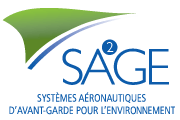AIRCRAFT FOR TOMORROW'S DIGITAL AND GREEN MOBILITY (PMD2)
This project is a collaboration of Bell Textron Canada Limited, Beslogic, CAE, the Flight Test Centre of Excellence (3C), MTLS Aerostructure and Pratt & Whitney Canada (P&WC). It aims to accelerate the development of technologies, digital transformation and knowledge that will enable the partners to certify and commercialize aircraft and services for sustainable, safe, efficient, and socially accepted mobility. This mobility will be digital and green, for the transportation of goods and passengers.
Three axes of development
The project includes three development axes to advance the level of maturity of technologies that could benefit the aircraft of the future.
-
Develop and validate technologies related to the improvement and electrification of propulsion systems. These systems could be hybrid or fully electric. This component will aim at neutrality or decarbonization of air transport systems.
-
Valorize data and ensure the efficiency and reliability of vehicles and services for tomorrow’s mobility through digitalization, whether for the design of new products, to support operations or for training.
-
Certify the technologies developed, because it is only once they are put into service that the technologies developed will produce the expected economic, environmental, and social benefits, in addition to enabling the partners to be leaders in their field.
Electrification
The POUSSÉE sub-project
Within the framework of POUSSÉE-IIa, Bell aims to develop an electric propulsion system for helicopters to improve social acceptability and electric motorization. Social acceptability involves the development of environmentally friendly, safe, and quieter technologies. The electric motorization includes the development of greener and more sustainable technologies.
Its objective is to develop a helicopter powered by a thermal turbine engine into an electric helicopter that will serve as a platform to create vertical take-off vehicles. This will be a base for flight tests to certify the main performance. This project aims to demonstrate that the electrically distributed anti-torque (EDAT) system is commercially sustainable.
This work will be in addition to the work being conducted under the SA2GE-3 mobilization project and the Technology Demonstration Program (TDP) to improve propulsion system performance and efficiency and reduce external noise and aircraft weight.
CAE’s Future Aircraft sub-project
CAE will contribute to the project by developing energy storage technologies related to advanced air mobility (AAM) applications with batteries manufactured for electrical aircraft. To convert the conventional aircraft to electric aircraft, structural modifications to the airframe, an electric propulsion system, an aircraft cockpit user-machine interface and a cabin cooling system will be required. These developments will design light aircraft with electric or hybrid engines. To accelerate this development, platforms and tools based on modelling, simulation and synthetic environment will be used.
PT6 Hybrid Electric Turbogenerator Project
As a continuation of MTLS Aerostructure’s research and development projects, MTLS Aerostructure intends to develop a 1 MW turbogenerator to equip the aircraft with electric propulsion—to reduce greenhouse gas (GHG) emissions—as well as aircraft with hybrid electric propulsion from Flying Whales. It will work on traditional logistics and production schemes. This solution could benefit isolated communities to move heavy loads without requiring the installation of costly and environmentally damaging infrastructure.
This work will require 3 to 4 years to reach the maturity necessary to put the turbogenerator system in the air.
Digital transformation
Full Product Lifecycle Digital Transformation
Beslogic will optimize P&WC’s customer experience and service, operational systems, and employee satisfaction using digital technologies. Their knowledge of software development and automated work processes will be put to good use.
The project aims to:
-
Process data from social media and aerospace-specific websites to improve service offerings.
-
Develop and incorporate machine learning techniques to implement a recommendation system that includes product description, user profile and results from the Diagnostic, Prognostic and Health Management (DPHM) engine predictive analysis service.
-
Develop and integrate an artificial intelligence-based search engine to analyze available engine data sources.
-
Develop DPHM predictions to better understand equipment, engines, and interactions with various components.
P&WC will also contribute to the digital transformation by implementing digital infrastructure for design data to improve the customer experience. Improving the capability of design, analysis and integration systems will optimize current practices using artificial intelligence and machine learning technologies. Acquiring data from within and outside the enterprise will enable interconnected infrastructure for all stakeholders in the enterprise.
This digital transformation will increase the accuracy of product searches by users, reduce search time and create a better experience. It will also help show similar or complementary parts to increase sales.
Certification
Centre for Future Aerospace Technology Evaluation, Flight Test and Certification (CFATE)
Aerospace technology certification is the single largest cost and risk factor for all civil aerospace programs. The time required to obtain certification can create product launch delays if not done efficiently.
To address the approval challenges, the Flight Test Center of Excellence (FTCE) aims to establish a Center for Future Aerospace Technology Evaluation, Flight Test and Certification (CFATE) at St-Hubert Airport.
To accomplish this project, a portion of CCC will be relocated to the St-Hubert Airport, an aircraft will be obtained for flight testing with its Data Acquisition System (DAS) equipment, and data analysis capabilities will be obtained through the Aerospace Technology Center (CTA). These tasks will require the hiring of design engineering, flight analysis, and flight test engineering personnel to assist the CCC staff.




